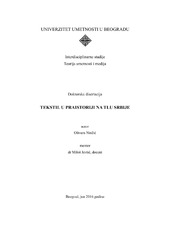Tekstil u praistoriji na tlu Srbije
докторска дисертација
Метаподаци
Приказ свих података о записуДокторанд:
Ninčić, OliveraФакултет:
Интердисциплинарне студије Универзитета уметностиДатум одбране:
30-09-2016Ментор:
Jevtić, MilošЧланови комисије:
- Šuica, Nikola
- Tasić, Nenad
- Ljuština, Marija
- Živković, Irena
Сажетак
U radu Tekstil u praistoriji na tlu Srbije istraženi su arheološki dokazi proizvodnje
tekstila u praistoriji od ranog neolita do gvozdenog doba. Obuhva eno je više od 160 naselja
sa razli itim predmetima koji mogu da se povežu sa nekim oblikom izrade ili upotrebe
tekstila. Ozna eni su kao potencijalni alat u proizvodnji tekstila. Nalazi su iz naselja
star eva ke i vin anske kulture, preko eneolitskih kultura bakarnog doba, bronzanodobnih
nalaza, do pojave gvož a na tlu Srbije. Akcenat je dat na tehnološke mogu nosti, odnosno na
istraživanje predmeta specijalizovanih za proizvodnju i preradu tekstila. Utvr ene su
procedure istraživanja i metodologija analize arheoloških predmeta i otisaka strukutra.
Tegovi za tkanje i pršljenci su tipološki opredeljeni u klase po morfologiji i ispitana su radna
ošteć enja.
Izvori informacija su arheološka dokumentacija i predmeti od razli itih materijala,
osnovano vezani za proizvodnju, preradu, doradu i oblikovanje tekstila. Ispitani su pred...meti
koštane industrije: igle, noževi za tkanje, plo ice sa perforacijama. Kerami ki oblici su:
tegovi, pršljenci, kalemi, sudovi sa otiscima tekstilnih struktura na dnu ili recipijentu.
Antropomorfne figurine pominjane u radu su ispitane po mogu nosti upotrebe tekstila u
odevanju.
Posebno su ispitani kontekstualni dokazi postojanja razboja sa tegovima u ku ama
vin anske kulture. Grupe tegova prona ene u ku ama iz naselja Vin a Belo brdo, Obrež
Baštine, Gomolava, Crkvine Mali Borak analizirane su po mogu nosti upotrebe na razboju.
Utvr ena je nedvosmislena veza tegova i razboja, izvršena rekonstrukcija potencijalnog
položaja u sklopu razboja i istraženo rasejanje tegova pri padu na pod.
Otisci struktura prepleta na dnu sudova pokazali su izvesnu homogenost. Skoro svi su
tip pletarske strukture, izra ene od neprera ene sirove biljke dvostrukim uvratnjem potke
preko pasivne osnove, delovi manjih predmeta izra enih rukom.
Visok stepen korelacije izme u kulture i sredstava za proizvodnju tekstilnih površine
ogleda se u pojavi odre enih tipova alata u korpusu arheoloških predmeta, izrazitoj
eksploataciji i nestajanju u novim kulturama.
In the dissertation Prehistoric Textile in Serbia we have researched archeological
evidence related to textile production in the prehistoric period from the early Neolithic to the
Iron Age. In this study, more than 160 settlements have been encompassed where diverse
artifacts had been found which could be linked to some form of textile making or its usage.
These artifacts have been designated as potential tools in the production of textile. The
findings belong to settlements from the Starcevo and Vin a cultures, ranging from Eneolithic
cultures of the Copper Age, across various Bronze Age findings, to the appearance of the Iron
Age on Serbian soil. Accent has been given to the possibility of the existence of textile
producing technology, i.e., research has been conducted related to artifacts that were
specialized for the production and processing of textile. We have determined the research
procedures and the methodology for analysis of the archeological artifact and imprinted...
structures. Loom weights and spindle whorls have been classified, typologically, according to
their morphology and we have examined the wear and tear of these artifacts in the production
process itself.
Our sources of information were derived from relevant archeological documentation
as well as artifacts made of different materials, but which are credibly linked to production,
processing, finishing work and shaping of textile. In our research, we have examined artifacts
that belong to bone industries: needles, weaving knives, and small tile-plates with
perforations. The ceramic implements are weights, spindle whorls, spools, vessels with
remains of imprinted textile patterns and structures on the bottom of the vessels. The
anthropomorphic figurines mentioned in the study have been examined according to the
likely usage of textiles for the purpose of clothing.
We have, especially, examined and researched the contextual evidence related to the
existence of looms with weights in the dwellings belonging to the Vin a culture. Groups of
weights that have been found in the houses and dwellings located in the settlements of Vin a
Belo Brdo, Obrež Bastina, Gomolava, and Crkvine Mali Borak have been analyzed according
to the likelihood of loom usage. An unequivocal connection has been determined related to
the weights and looms, and we have performed reconstructions of their potential positions
within and on the looms and have explored their displacement positions resulting from their
falling to the floor.
The accidentally imprinted patterns of woven structures on the outside bottom of the
found vessels have shown certain homogeneity. Almost all of them are of the inter-twined
type pattern structure made of unprocessed raw plants by means of the double inter-twining
of the weft over the passive warp, parts of smaller hand-made objects.
A high degree of correlation between the culture and means of production of textile
surfaces is reflected in the reappearance of certain types of tools in the corpus of
archeological artifacts, evidence of their considerable exploitation and their disappearance in
the later, succeeding cultures.

